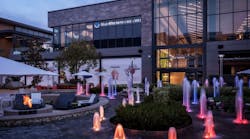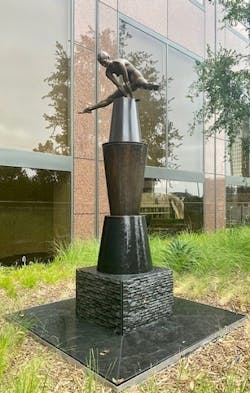An interesting side effect of the pandemic is that it prompted people to spend more time outdoors, where the risk of viral transmission was diminished.
As everyone turned to alfresco dining, park gatherings and other open-air activities, building owners and facility professionals shifted their focus to outdoor spaces. In addition to ensuring compliance with health and safety protocols, stakeholders were also concerned about improving the aesthetic appeal of these spaces. And they wondered how to leverage the public’s increasing attraction to outdoor areas to maximize property value during a period of economic uncertainty and after the crisis has subsided.
Time and again, our company has seen how water features elevate the value of commercial property while beautifying it and promoting sustainability. Also, as outdoor spaces grow in popularity, we have noticed the many ways water features improve people’s experience of these places and benefit stakeholders. Here are a few of the ways water features enhance outdoor public spaces in a post-COVID world.
[Related: How Water Features Contribute to Conservation and Cost Savings]
1. Outdoor water features offer multiple health benefits.
Being outside allows people to connect with nature, which promotes health and wellness. Proximity to water is an important aspect of biophilic design, and water features augment these healthful effects.
There is evidence that being near water lowers stress and obesity, improves mental and emotional health, and imbues a general sense of wellbeing. Similarly, water features provide calming sounds and sights that help us all relax and de-stress, which is especially desirable during this unprecedented time.
An example of this is Halo, a next-generation food hall situated at street level in the Wells Fargo Plaza in downtown Los Angeles, California. OTL created a series of delightful water features at this venue to complete the setting for four bronze sculptures created by the late artist Robert Graham. The rippling water of these fountains evokes a sense of calm amid the bustle of the busy downtown site.
As people increasingly turn to outdoor public spaces for peace of mind, property stakeholders will continue to add amenities to these spaces that will help soothe and heal.
2. These amenities increase length of stay and encourage repeat visits.
When visitors feel relaxed and calm in a particular setting, they want to linger longer and return to it again and again. A peaceful environment in the open air, such as a park or public garden, where birds are chirping and the wind is gently blowing, is especially inviting. The sights and sounds of flowing water, or the enchanting activity of a choreographic show fountain, complete the picture.
A perfect example is the garden fountain created for Hillsdale Mall in San Mateo, California. OTL worked with the landscape architects to create a one-of-a-kind dancing fountain integrated into the gardens. The result is recognized as public art by the City of San Mateo and creates a setting where people want to remain longer and are enticed to revisit multiple times.
[Related: LEED Certification Tips: Water Efficiency]
3. Outdoor water features promote sustainability.
Sustainability is a growing concern among public space stakeholders as this issue becomes increasingly important to investors and the general population. Recognizing that sustainability is good for the planet and positively impacts the bottom line, those involved in these spaces are seeking amenities that are ecologically friendly and protect our natural resources while adding value.
Water features are ideal for promoting sustainability in outdoor public spaces for a variety of reasons. Counterintuitively, these amenities lose less water to evaporation than similarly sized lawns or planted areas, can conserve water by using recycled water, and feature technology like LED lighting, VFD-driven pumps and remote control that ensures energy conservation.
There are sustainability benefits to the buildings near these exterior spaces as well. Water features can be combined with buildings’ mechanical systems to function as geothermal heat sinks or as aesthetically pleasing replacements for cooling towers, reducing energy usage substantially. This is a boon to the building’s overall environment and has a powerful positive economic impact for property owners and managers.
As people continue to spend more time outside in our post-COVID world, water features are the perfect way to enhance the outdoor public spaces they are drawn to. By offering multiple health benefits, increasing length of stay and encouraging repeat visits, and promoting sustainability, outdoor water features enhance the value of these spaces while providing a wealth of benefits for property owners and public space stakeholders for many years to come.
About the Author:
Chris Roy is director of creative design for OTL.
Read next: Is Your Water Safe for Reoccupancy?




